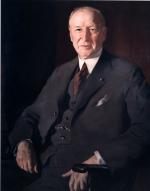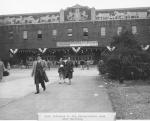![header=[Marker Text] body=[Governor of Pennsylvania, 1927-1931, was born on a farm, 1 mile NE of here, in 1867. He supported an extensive State building program, revised the State fiscal system, and promoted the conservation of natural resources. Died in 1940. ] sign](http://explorepahistory.com/kora/files/1/10/1-A-32F-139-ExplorePAHistory-a0l3j1-a_450.gif)
Mouse over for marker text
Name:
John S. Fisher
Region:
Laurel Highlands/Southern Alleghenies
County:
Indiana
Marker Location:
Junction Pa. 85 and 210 E of Plumville
Dedication Date:
September 14, 1950
Behind the Marker
He had the highest public approval rating of any Pennsylvania governor up to that time. Upon completion of his term as governor from 1927 to 1931, he was honored with a banquet given by the city of Harrisburg. At that banquet, Harrisburg mayor George A. Hoeverter summed up Fisher's four years in just two sentences: "John S. Fisher will leave a record of his administration written in granite. It is not by mere chance that Pennsylvania's chief executive is known as ‘Fisher the Builder.'"
John Stuchell Fisher was born in 1867 in South Mahoning Township, Indiana County, Pennsylvania. After graduating from the Pennsylvania State Normal School (now known as Indiana University of Pennsylvania) in 1886, Fisher worked as a teacher, lawyer, and businessman. In 1900, Fisher was elected to the state senate as a reformer. There, he sponsored the direct primary election law of 1906, and served as the chairman of the committee investigating the Capitol Graft Scandal in 1907. From 1919 to 1921 Fisher was state banking commissioner.
Popular and well-connected, he ran for governor in 1926 with the backing of the Republican party leaders Joseph R. Grundy and the Mellon family of Pittsburgh, and a broad base of support. Pledging "to manage the government with the same honesty or purpose as if it were a corporation," he beat Philadelphia Judge Eugene C. Bonniwell, his Democratic opponent, by a three-to-one margin. During the same election,
Joseph R. Grundy and the Mellon family of Pittsburgh, and a broad base of support. Pledging "to manage the government with the same honesty or purpose as if it were a corporation," he beat Philadelphia Judge Eugene C. Bonniwell, his Democratic opponent, by a three-to-one margin. During the same election,  Arthur James, who would become governor of Pennsylvania in 1939, was elected as the state's lieutenant governor.
Arthur James, who would become governor of Pennsylvania in 1939, was elected as the state's lieutenant governor.
True to his campaign promise, Fisher backed election reform bills, including the Corrupt Practices Act, which prescribed ethical norms for both candidates and voters, and the Davis-Harris Act, which promoted the use of automatic voting machines. In a nod to the progressive wing of the Pennsylvania GOP, he also supported the increase of workmen's compensation benefits, and the conversion of the two-year state normal schools into four-year teachers' colleges.
With experience in both business and as state banking commissioner, Fisher emphasized responsible fiscal management. Act 164, passed in 1927, introduced sweeping changes, including a new Department of Revenue to collect taxes, an Office of the Budget to monitor spending, and a new Department of Property and Supplies to control expenditures within state government and curb waste. Fisher was also, however, a party stalwart - unlike his predecessor Gifford Pinchot.
Gifford Pinchot.
After the United States Senate voided the election of Philadelphia Republican boss Bill Vare because of election fraud, Fisher in 1929 appointed Joe Grundy, head of the powerful Pennsylvania Manufacturers Association, to fill Vare's seat in the U.S. Senate. Grundy then introduced legislation known as "the Grundy Tariff," which some economists later argued hastened onset of the Great Depression.
In the months after the New York Stock Market crashed in October, Fisher continued to believe, along with President Hoover and other Republicans, that "prosperity was just around the corner." But one event after another kept proving them wrong. When Fisher took office in 1927, Pennsylvania counted almost a million workers employed in the manufacturing sector. By 1930, the state had the third highest unemployment rate in the country; more than 200,000 people were out of work and their numbers increasing daily.
Fisher, like other Republican leaders, was slow to respond to the deepening crisis. When the Poor Boards charged with administering relief in the counties were overwhelmed by the demand for assistance from the unemployed, he responded by ordering the delivery of 3,000 army cots and blankets to the needy in Allegheny and Philadelphia counties, where the largest number of unemployed lived. But he knew that this gesture was "just a drop in the bucket," for the other sixty odd Pennsylvania counties all needed help too.
In search of advice, Fisher wrote to President Herbert Hoover, who responded that "it would be helpful if road, street, public building, and other construction of this type could be speeded up and adjusted in such fashion to further employment." Although he doubted the wisdom of Hoover's advice- and placed Hoover's suggestions under the file heading of "Hoover's Prosperity Propaganda"- Fisher did step up building programs in Pennsylvania that would earn him the nickname of "The Builder." In Harrisburg, noteworthy buildings erected during Fisher administration include the Farm Show building and the Education building.
When Fisher stepped down from office in 1931, his political reputation remained largely intact. He would be remembered by his contemporaries as a nice guy who believed in "clean government." The worst, however, was yet to come. So it would be his successor, Gifford Pinchot, who would have to grapple with the deepening crisis and mounting public discontent in the years that followed.
After leaving office Fisher served as consultant to his son's law firm. John S. Fisher died in 1940 in Indiana, Pennsylvania.
John Stuchell Fisher was born in 1867 in South Mahoning Township, Indiana County, Pennsylvania. After graduating from the Pennsylvania State Normal School (now known as Indiana University of Pennsylvania) in 1886, Fisher worked as a teacher, lawyer, and businessman. In 1900, Fisher was elected to the state senate as a reformer. There, he sponsored the direct primary election law of 1906, and served as the chairman of the committee investigating the Capitol Graft Scandal in 1907. From 1919 to 1921 Fisher was state banking commissioner.
Popular and well-connected, he ran for governor in 1926 with the backing of the Republican party leaders
True to his campaign promise, Fisher backed election reform bills, including the Corrupt Practices Act, which prescribed ethical norms for both candidates and voters, and the Davis-Harris Act, which promoted the use of automatic voting machines. In a nod to the progressive wing of the Pennsylvania GOP, he also supported the increase of workmen's compensation benefits, and the conversion of the two-year state normal schools into four-year teachers' colleges.
With experience in both business and as state banking commissioner, Fisher emphasized responsible fiscal management. Act 164, passed in 1927, introduced sweeping changes, including a new Department of Revenue to collect taxes, an Office of the Budget to monitor spending, and a new Department of Property and Supplies to control expenditures within state government and curb waste. Fisher was also, however, a party stalwart - unlike his predecessor
After the United States Senate voided the election of Philadelphia Republican boss Bill Vare because of election fraud, Fisher in 1929 appointed Joe Grundy, head of the powerful Pennsylvania Manufacturers Association, to fill Vare's seat in the U.S. Senate. Grundy then introduced legislation known as "the Grundy Tariff," which some economists later argued hastened onset of the Great Depression.
In the months after the New York Stock Market crashed in October, Fisher continued to believe, along with President Hoover and other Republicans, that "prosperity was just around the corner." But one event after another kept proving them wrong. When Fisher took office in 1927, Pennsylvania counted almost a million workers employed in the manufacturing sector. By 1930, the state had the third highest unemployment rate in the country; more than 200,000 people were out of work and their numbers increasing daily.
Fisher, like other Republican leaders, was slow to respond to the deepening crisis. When the Poor Boards charged with administering relief in the counties were overwhelmed by the demand for assistance from the unemployed, he responded by ordering the delivery of 3,000 army cots and blankets to the needy in Allegheny and Philadelphia counties, where the largest number of unemployed lived. But he knew that this gesture was "just a drop in the bucket," for the other sixty odd Pennsylvania counties all needed help too.
In search of advice, Fisher wrote to President Herbert Hoover, who responded that "it would be helpful if road, street, public building, and other construction of this type could be speeded up and adjusted in such fashion to further employment." Although he doubted the wisdom of Hoover's advice- and placed Hoover's suggestions under the file heading of "Hoover's Prosperity Propaganda"- Fisher did step up building programs in Pennsylvania that would earn him the nickname of "The Builder." In Harrisburg, noteworthy buildings erected during Fisher administration include the Farm Show building and the Education building.
When Fisher stepped down from office in 1931, his political reputation remained largely intact. He would be remembered by his contemporaries as a nice guy who believed in "clean government." The worst, however, was yet to come. So it would be his successor, Gifford Pinchot, who would have to grapple with the deepening crisis and mounting public discontent in the years that followed.
After leaving office Fisher served as consultant to his son's law firm. John S. Fisher died in 1940 in Indiana, Pennsylvania.
Beyond the Marker







